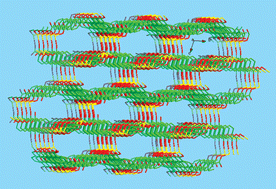A series of new metal–organic coordination complexes, {[Ni(IP)(H2O)4]·(2H2O)(SO4)} (1), [M(IP)(μ2-SO4)(H2O)2] (M = Zn 2, and M = Mn 3), {[M2(IP)2(μ2-SO4)2(H2O)4]·2H2O} (M = Zn 4, and M = Co 5), {[Mn2(IP)(μ2-SO4)(H2O)2]·(6.5H2O)(sdba)} (6), {[Mn(IP)2(H2O)2][Mn(pydc)2(H2O)2]·(4H2O)} (7), {[Mn(IP)(fum)(H2O)]·H2O} (8), {[M3(IP)3(fum)3]·(8H2O)} (M = Cd 9, and M = Zn 10), {[Cd2(IP)2(bptc)(H2O)2]·(7.3H2O)} (11), {[Zn2(IP)2(bptc)(H2O)2]·(3H2O)} (12), {Cd(1,4-BDC)(IP)(H2O)]·(0.5H2O)} (13), {[Mn(1,4-BDC)(IP)(H2O)]·H2O} (14), {[Zn2(1,4-BDC)2(IP)]·2.5H2O} (15) (IP = 1H-imidazo[4,5-f][1,10]-phenanthroline, H2sdba = 4,4′-sulfonyldibenzoic acid, H2pydc = pyridine-2,6-dicarboxylic acid, H2fum = fumaric acid, H4bptc = 3,3′,4,4′-benzophenonetetracarboxylic acid and 1,4-H2BDC = 1,4-benzendicarboxylic acid) were prepared viaself-assembly of pharmaceutical agent IP with different metal sulfates in the absence/presence of the carboxylate under mild conditions. All these compounds were structurally determined by single-crystal X-ray diffraction. Compounds 2–6 crystallize with N-donor chelating ligands and sulfate anion linkers. Complexes 2–6 possess sulfate anions with μ2-bridging modes, the roles of sulfate anions result in 1D chains (2 and 3) and dinuclear units (4, 5 and 6). For complex 7, two different Mn units are chelated by two IP and pydc ligands, respectively. Compound 8 is a 1D chain connected by fum ligands. Polymers 9–12 exhibit 2D network structures composed of tetrametallic and hexametallic clusters. The Cd(II)/Zn(II) layers are interdigitated in pairs for complexes 11 and 12 by stacking forces, which exhibit unusual 2D→3D interdigitated architectures. In 13 and 14, they show 1D undulating and linear chains due to the different coordinate modes of 1,4-BDC. IP firstly acts in a tridentate mode via the two N atoms of pyridyl rings and the third N atom of imidazole ring, and the two carboxylate groups of 1,4-BDC ligand taking three types of coordinative modes connect Zn atoms into a complicated 3D network in 15. The structural differences among complexes 1–15 indicate the backbone of such dicarboxylate ligands, nature of metal resources and the ratio of metal to ligand play important roles in modulating the formation of the coordination polymers. Thermal stabilities of these crystalline materials, fluorescent properties of these complexes and TD-DFT calculation of spectra of IP were also investigated.


 Please wait while we load your content...
Please wait while we load your content...